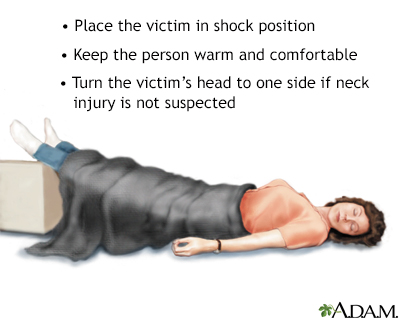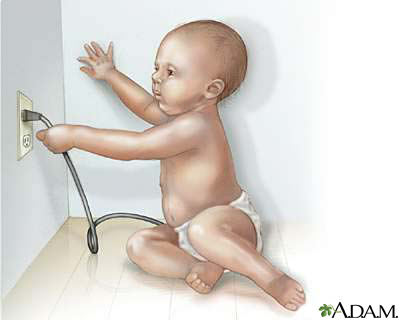Electrical injury
Electrical shock
An electrical injury is damage to the skin or internal organs when a person comes into direct contact with an electrical current.
Images


Considerations
The human body conducts electricity very well. That means electricity passes easily throughout the body. Direct contact with electrical current can be deadly. While some electrical burns look minor, there may be serious internal damage, especially to the heart, muscles, or brain.
Electric current can cause injury in four ways:
- Cardiac arrest due to the electrical effect on the heart
- Muscle, nerve, and tissue destruction from a current passing through the body
- Thermal burns from contact with the electrical source
- Falling or injury after contact with electricity
Causes
Electrical injury can be caused by:
- Accidental contact with power outlets, power cords, or exposed parts of electrical appliances or wiring
- Flashing of electric arcs from high-voltage power lines
- Lightning
- Machinery or occupational-related exposures
- Young children biting or chewing on electrical cords, or poking metal objects into an electrical outlet
- Electrical weapons (such as a Taser)
Symptoms
Symptoms depend on many things, including:
- Type and strength of voltage
- How long you were in contact with the electricity
- How the electricity moved through your body
- Your overall health
Symptoms may include:
- Changes in alertness (consciousness)
- Broken bones
- Heart attack (chest, arm, neck, jaw, or back pain)
- Headache
- Problems with swallowing, vision, or hearing
- Irregular heartbeat
- Muscle spasms and pain
- Numbness or tingling
- Breathing problems or lung failure
- Seizures
- Skin burns
First Aid
- If you can do so safely, turn off the electrical current. Unplug the cord, remove the fuse from the fuse box, or turn off the circuit breakers. Simply turning off an appliance may not stop the flow of electricity. Do not attempt to rescue a person near active high-voltage lines.
- Call 911 or the local emergency number.
- If the current can't be turned off, use a non-conducting object, such as a broom, chair, rug, or rubber doormat to push the person away from the source of the current. Do not use a wet or metal object. If possible, stand on something dry that doesn't conduct electricity, such as a rubber mat or folded newspapers.
- Once the person is away from the source of electricity, check the person's airway, breathing, and pulse. If either has stopped or seems dangerously slow or shallow, start first aid.
- CPR should be started if the person is unconscious and you can't feel a pulse. Perform rescue breathing on a person who is unconscious and not breathing or is breathing ineffectively.
- If the person has a burn, remove any clothing that comes off easily and rinse the burned area with cool, running water until the pain subsides. Give first aid for burns.
- If the person is faint, pale, or shows other signs of shock, lay them down, with the head slightly lower than the trunk of the body and the legs elevated, and cover them with a warm blanket or a coat.
- Stay with the person until medical help arrives.
- Electrical injury is frequently associated with explosions or falls that can cause additional severe injuries. You may not be able to notice all of them. Do not move the person's head or neck if the spine may be injured.
- If you are a passenger in a vehicle struck by a power line, remain in it until help arrives unless a fire has started. If necessary, try to jump out of the vehicle so that you do not maintain contact with it while also touching the ground.
Do Not
- Do not get within 20 feet (6 meters) of a person who is being electrocuted by high-voltage electrical current (such as power lines) until the power is turned off.
- Do not touch the person with your bare hands if the body is still touching the source of electricity.
- Do not apply ice, butter, ointments, medicines, fluffy cotton dressings, or adhesive bandages to a burn.
- Do not remove dead skin or break blisters if the person has been burned.
- After the power is shut off, do not move the person unless there is an ongoing risk, such as a fire or explosion.
When to Contact a Medical Professional
Call 911 or the local emergency number, if a person has been injured by electricity.
Prevention
- Avoid electrical hazards at home and at work. Always follow the manufacturer's safety instructions when using electrical appliances.
- Avoid using electrical appliances while showering or wet.
- Keep children away from electrical devices, especially those that are plugged in to an electrical outlet.
- Keep electrical cords out of children's reach.
- Never touch electrical appliances while touching faucets or cold water pipes.
- Teach children about the dangers of electricity.
- Use child safety plugs in all electrical outlets.
Related Information
BurnsReferences
Chen P, Bukhman AK. Electrical and lightning injuries. In: Walls RM, ed. Rosen's Emergency Medicine: Concepts and Clinical Practice. 10th ed. Philadelphia, PA: Elsevier; 2023:chap 130.
Cooper MA, Andrews CJ, Holle RL, Blumenthal R, Aldana NN. Lightening-related injuries and safety. In: Auerbach PS, Cushing TA, Harris NS, eds. Auerbach's Wilderness Medicine. 7th ed. Philadelphia, PA: Elsevier; 2017:chap 5.
Price LA, Loiacono LA. Electrical injury and lightning injury. In: Cameron JL, Cameron AM, eds. Current Surgical Therapy. 14th ed. Philadelphia, PA: Elsevier; 2023:1433-1442.
Sheridan RL. Medical aspects of trauma and burns. In: Goldman L, Cooney KA, eds. Goldman-Cecil Medicine. 27th ed. Philadelphia, PA: Elsevier; 2024:chap 97.
BACK TO TOPReview Date: 11/2/2023
Reviewed By: Jesse Borke, MD, CPE, FAAEM, FACEP, Attending Physician at Kaiser Permanente, Orange County, CA. Also reviewed by David C. Dugdale, MD, Medical Director, Brenda Conaway, Editorial Director, and the A.D.A.M. Editorial team.

Health Content Provider
06/01/2025
|
A.D.A.M., Inc. is accredited by URAC, for Health Content Provider (www.urac.org). URAC's accreditation program is an independent audit to verify that A.D.A.M. follows rigorous standards of quality and accountability. A.D.A.M. is among the first to achieve this important distinction for online health information and services. Learn more about A.D.A.M.'s editorial policy, editorial process and privacy policy. A.D.A.M. is also a founding member of Hi-Ethics. This site complied with the HONcode standard for trustworthy health information from 1995 to 2022, after which HON (Health On the Net, a not-for-profit organization that promoted transparent and reliable health information online) was discontinued. |
The information provided herein should not be used during any medical emergency or for the diagnosis or treatment of any medical condition. A licensed medical professional should be consulted for diagnosis and treatment of any and all medical conditions. Links to other sites are provided for information only -- they do not constitute endorsements of those other sites. © 1997- 2025 A.D.A.M., a business unit of Ebix, Inc. Any duplication or distribution of the information contained herein is strictly prohibited.
